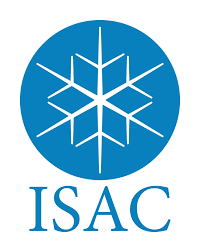The International Study of Arctic Change (ISAC) is an open-ended, international, interdisciplinary Arctic environmental change program initiated in 2003 by the International Arctic Science Committee (IASC) and the Arctic Ocean Sciences Board. ISAC encompasses pan-Arctic, system-scale, multidisciplinary observations, synthesis and modelling to provide an integrated understanding of Arctic change and projections of future change. The ISAC Science Plan provides a vision for integrating research and applications among diverse fields and varied users and stakeholders.
ISAC is motivated by environmental changes that are already large enough to affect life for Northern communities, biodiversity, ecosystems, and regions within and outside the Arctic. Future system states are uncertain and the lack of predictability hinders efforts to develop strategies for adapting to and managing a changing Arctic.
The ISAC International Program Office co-ordinates the Arctic Observing Summit in collaboration with SAON and IASC.
ISAC is motivated by environmental changes that are already large enough to affect life for Northern communities, biodiversity, ecosystems, and regions within and outside the Arctic.

The ISAC International Program Office (IPO) is located at the Arctic Institute of North America, University of Calgary, Alberta, Canada.
The ISAC IPO is responsible for coordinating the activities of the ISAC Science Steering Group (SSG), facilitating collaboration among different Arctic research programs, improving cooperation in Arctic science, and providing information about ISAC related and ISAC relevant initiatives. The IPO organizes meetings and workshops designed to address key scientific issues, including those relevant to platform and data sharing, and the IPO maintains a catalogue of programs that contribute to ISAC. The staff and collaborators at the ISAC IPO also conduct research, participate in synthesis activities, engage with diverse sectors, participate in outreach and presentations, and prepare reports and publications.

ISAC partners with international organizations and scientific programs:
Observing Change: An international, integrated, comprehensive, and sustained Arctic observing system responsive to scientific and societal needs for information on Arctic change.
Understanding Change: To improve projections of the Arctic system and identify emerging issues.
Responding to Change: Developing and communicating science for problem solving, managing, and adapting to future Arctic changes.
ISAC is a program that provides a scientific and organizational framework focused around its key science questions for pan-Arctic research including long-term planning and priority setting.
ISAC establishes new and enhances existing synergies among scientists and stakeholders engaged in Arctic environmental research and governance.
ISAC promotes observations, synthesis, and modelling activities to provide an integrated understanding of the past, present and future Arctic environment needed for responding to change.
ISAC fosters links between Arctic environmental change initiatives and relevant global programs.
ISAC, in collaboration with partner organizations, provides authoritative and timely scientific information to stakeholders and decision-makers for responding to rapid Arctic environmental change.
ISAC research and synthesis activities are guided by the following:
1. How is the Arctic linked to global change?
2. How persistent is the presently observed arctic change and is it unique?
3. How large is the anthropogenic component of observed arctic change compared to natural variability?
4. What are many aspects of arctic change amplified with respect to global conditions?
5. How well can arctic change be projected and what is needed to improve projections?
6. What are the adaptive capacities and resilience of arctic ecological systems?
7. To what extent are ecological systems able to adapt to the effects of arctic change?
8. How does environmental change in the Arctic affect the resilience, adaptive capacity, and ultimately the viability of human communities?
9. How can new insights into arctic change and its impacts be translated into solutions for increased adaptation, management, and mitigation?